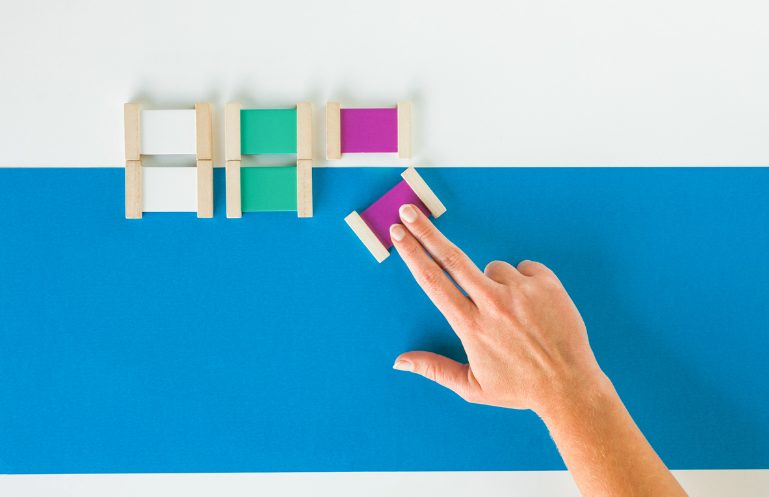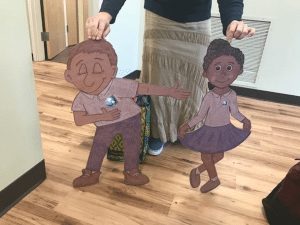Montessori Color Tablets
Montessori teaches color using a material called the Color Tablets. This material isolates the concept of color first. After conceptualization, color names are taught. Finally, children classify colors by ordering them from darkest to lightest.
The Montessori color tablets are small, rectangular pieces. They are shaped and sized exactly the same, but each is painted a unique shade. In Montessori, we always try to isolate the concept we are trying to teach by keeping everything else the same.
This material is designed very intentionally to not associate colors with any particular object. This can be confusing to young children.
The Montessori color tablets have handles on each side so the child can view the color without covering it with his fingers. This also prevents them from becoming discolored or getting dirty.
The tablets are introduced in a progression of three boxes. The first lessons require no language at all, only modeling. By the end of the progression, however, children will have vocabulary and phrases to use to describe color in detail.
Montessori Color Box 1
The first Montessori color tablet box in the series contains two tablets of each of the primary colors: red, yellow, and blue.
The first lesson matches identical colors. We do not name the colors. We isolate the visual concept of color through matching. This builds visual discrimination skills.
Once the child has a solid understanding of what color really means from the first Montessori color box, we teach the names. To do this, we use a three period lesson. For example:
“This is red. This is yellow. This is blue.”
“Can you show me red?” (child points)
“Can you show me blue?” (child points)
And finally,
“What is this?”
We move through the three period lesson when the child masters each step. We step back to the previous period if the child answers incorrectly. In this way we never have to condemn wrong answers. Rather they act as a guide for how the child needs to be taught.
Montessori Color Box 2
This box includes two tablets each for the primary and secondary colors. It also contains a few other common colors.
The secondary colors are made from mixing the primary colors. They are orange, green, and purple. Color Box 2 also has pairs of pink, brown, grey, black, and white.
This box is introduced exactly as Color Box 1. First the child matches identical colors. Next, the color names are taught using a three period lesson.
Montessori Color Box 3
This set includes various shades of nine different colors: red, orange, yellow, green, blue, purple, pink, brown, and a grey scale that spans black to white.
The task is to line up the tablets from each hue from darkest to lightest. In this work, the child learns comparative language such as “lighter” and “darker” and superlatives such as “lightest” and “darkest”.
Montessori Color Box 3 goes past basic color identification and into classification. Classification really is the purpose of the sensorial curriculum. It exists to help the child form an order to the world around her. In the case of the color tablets, the visual sense is targeted.
Extension: Color Hunt
A fun way to expand upon color study is to take a tablet along on a nature walk. Students search for objects that match their tablet as they walk.
An alternative is to match tablets to beautiful works of art in books, posters, or even museums.
Extension: Color across the Room
Another Montessori color extension has students look at one tablet and then walk or run to another location to retrieve its match. This is great for memory and visual discrimination. It also meets children’s need to be highly physical and active in their learning.
Both of these extensions are fun. At the start of the Montessori color tablets, the child should be primed with interest. Later, real life applications and making learning into a game will keep their learning blooming.
For more information on Montessori Kids Universe click here!


